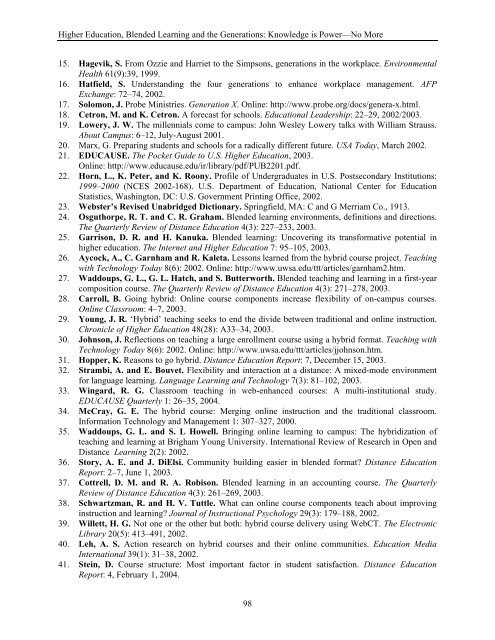Elements of Quality Online Education cation
Elements of Quality Online Education cation
Elements of Quality Online Education cation
You also want an ePaper? Increase the reach of your titles
YUMPU automatically turns print PDFs into web optimized ePapers that Google loves.
Higher <strong>Edu<strong>cation</strong></strong>, Blended Learning and the Generations: Knowledge is Power—No More15. Hagevik, S. From Ozzie and Harriet to the Simpsons, generations in the workplace. EnvironmentalHealth 61(9):39, 1999.16. Hatfield, S. Understanding the four generations to enhance workplace management. AFPExchange: 72–74, 2002.17. Solomon, J. Probe Ministries. Generation X. <strong>Online</strong>: http://www.probe.org/docs/genera-x.html.18. Cetron, M. and K. Cetron. A forecast for schools. <strong>Edu<strong>cation</strong></strong>al Leadership: 22–29, 2002/2003.19. Lowery, J. W. The millennials come to campus: John Wesley Lowery talks with William Strauss.About Campus: 6–12, July-August 2001.20. Marx, G. Preparing students and schools for a radically different future. USA Today, March 2002.21. EDUCAUSE. The Pocket Guide to U.S. Higher <strong>Edu<strong>cation</strong></strong>, 2003.<strong>Online</strong>: http://www.educause.edu/ir/library/pdf/PUB2201.pdf.22. Horn, L., K. Peter, and K. Roony. Pr<strong>of</strong>ile <strong>of</strong> Undergraduates in U.S. Postsecondary Institutions:1999–2000 (NCES 2002-168). U.S. Department <strong>of</strong> <strong>Edu<strong>cation</strong></strong>, National Center for <strong>Edu<strong>cation</strong></strong>Statistics, Washington, DC: U.S. Government Printing Office, 2002.23. Webster’s Revised Unabridged Dictionary. Springfield, MA: C and G Merriam Co., 1913.24. Osguthorpe, R. T. and C. R. Graham. Blended learning environments, definitions and directions.The Quarterly Review <strong>of</strong> Distance <strong>Edu<strong>cation</strong></strong> 4(3): 227–233, 2003.25. Garrison, D. R. and H. Kanuka. Blended learning: Uncovering its transformative potential inhigher edu<strong>cation</strong>. The Internet and Higher <strong>Edu<strong>cation</strong></strong> 7: 95–105, 2003.26. Aycock, A., C. Garnham and R. Kaleta. Lessons learned from the hybrid course project. Teachingwith Technology Today 8(6): 2002. <strong>Online</strong>: http://www.uwsa.edu/ttt/articles/garnham2.htm.27. Waddoups, G. L., G. L. Hatch, and S. Butterworth. Blended teaching and learning in a first-yearcomposition course. The Quarterly Review <strong>of</strong> Distance <strong>Edu<strong>cation</strong></strong> 4(3): 271–278, 2003.28. Carroll, B. Going hybrid: <strong>Online</strong> course components increase flexibility <strong>of</strong> on-campus courses.<strong>Online</strong> Classroom: 4–7, 2003.29. Young, J. R. ‘Hybrid’ teaching seeks to end the divide between traditional and online instruction.Chronicle <strong>of</strong> Higher <strong>Edu<strong>cation</strong></strong> 48(28): A33–34, 2003.30. Johnson, J. Reflections on teaching a large enrollment course using a hybrid format. Teaching withTechnology Today 8(6): 2002. <strong>Online</strong>: http://www.uwsa.edu/ttt/articles/jjohnson.htm.31. Hopper, K. Reasons to go hybrid. Distance <strong>Edu<strong>cation</strong></strong> Report: 7, December 15, 2003.32. Strambi, A. and E. Bouvet. Flexibility and interaction at a distance: A mixed-mode environmentfor language learning. Language Learning and Technology 7(3): 81–102, 2003.33. Wingard, R. G. Classroom teaching in web-enhanced courses: A multi-institutional study.EDUCAUSE Quarterly 1: 26–35, 2004.34. McCray, G. E. The hybrid course: Merging online instruction and the traditional classroom.Information Technology and Management 1: 307–327, 2000.35. Waddoups, G. L. and S. L Howell. Bringing online learning to campus: The hybridization <strong>of</strong>teaching and learning at Brigham Young University. International Review <strong>of</strong> Research in Open andDistance Learning 2(2): 2002.36. Story, A. E. and J. DiElsi. Community building easier in blended format? Distance <strong>Edu<strong>cation</strong></strong>Report: 2–7, June 1, 2003.37. Cottrell, D. M. and R. A. Robison. Blended learning in an accounting course. The QuarterlyReview <strong>of</strong> Distance <strong>Edu<strong>cation</strong></strong> 4(3): 261–269, 2003.38. Schwartzman, R. and H. V. Tuttle. What can online course components teach about improvinginstruction and learning? Journal <strong>of</strong> Instructional Psychology 29(3): 179–188, 2002.39. Willett, H. G. Not one or the other but both: hybrid course delivery using WebCT. The ElectronicLibrary 20(5): 413–491, 2002.40. Leh, A. S. Action research on hybrid courses and their online communities. <strong>Edu<strong>cation</strong></strong> MediaInternational 39(1): 31–38, 2002.41. Stein, D. Course structure: Most important factor in student satisfaction. Distance <strong>Edu<strong>cation</strong></strong>Report: 4, February 1, 2004.98
















